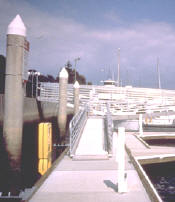
“Whenever any barrier stands between you and the full rights and dignity of citizenship, we must work to remove it, in the name of simple decency and justice. The promise of the ADA…has enabled people with disabilities to enjoy much greater access to a wide range of affordable travel, recreational opportunities and life-enriching services.”
President George W. Bush, New Freedom Initiative, February 1, 2001
Accessible Boating
The recreation facility guidelines described in this guide focus on newly designed or newly constructed and altered boating facilities. Other provisions contained in ADAAG address elements commonly found at a boating facility, such as accessible vehicle parking spaces, exterior accessible routes, and toilet and bathing facilities. ADAAG addresses only the built environment (structures and grounds). The guidelines do not address operational issues of a facility. Questions regarding operational issues should be directed to the Department of Justice, 1-800-514-0301 or 1-800-514-0383 (TTY).
Recreational boating facilities can include fixed and floating facilities. Facilities can vary in size from one boat slip (for example, at a small campground facility) to several thousand slips, and can handle boats ranging in size from small canoes to large sailboats and powerboats. Facilities may be located in the same waterfront area or even in the same site (such as a State park with a large lake) and include marinas, launching facilities, piers, and docks that are designed for recreational use.
These guidelines do not cover the design of passenger vessels or ferry docks, and do not address access on and off passenger vessels. These issues will be addressed in future rulemaking for passenger vessels.
Accessible Routes
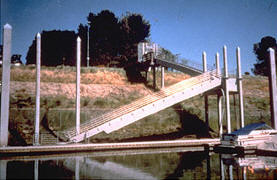 ADAAG requires that at least one accessible route connect
accessible buildings, facilities, elements, and spaces on a site.
Accessible boat slips, accessible boarding piers at boat launch
ramps,and other accessible spaces and elements within a boating facility
must also be connected by an accessible route. The accessible route must
comply with ADAAG provisions for the location, width (minimum of 36
inches), passing space,head room, surface, slope (maximum of 1:12 or
8.33%), changes in level, doors, egress, and areas of rescue assistance,
unless otherwise modified by specific provisions outlined in this guide.
ADAAG requires that at least one accessible route connect
accessible buildings, facilities, elements, and spaces on a site.
Accessible boat slips, accessible boarding piers at boat launch
ramps,and other accessible spaces and elements within a boating facility
must also be connected by an accessible route. The accessible route must
comply with ADAAG provisions for the location, width (minimum of 36
inches), passing space,head room, surface, slope (maximum of 1:12 or
8.33%), changes in level, doors, egress, and areas of rescue assistance,
unless otherwise modified by specific provisions outlined in this guide.
Gangways
A gangway is a variable-sloped pedestrian walkway linking a fixed structure or land with a floating structure. Where gangways are provided as part of accessible routes to connect accessible boat slips on floating piers, the following exceptions to the ADAAG accessible route provisions have been included in the guidelines to deal with the varying water level changes and other factors in this dynamic environment. Designers and operators should note that there are no exceptions to the accessible route requirements where the accessible route connects fixed piers to land or other fixed structures.

Gangway Slope and Rise Exceptions
Gangways designed for the least possible slope will provide more independent access for persons with disabilities. As a minimum however, gangways must be designed to provide for a maximum 1:12 (8.33%) slope but are not required to be longer than 80 feet in length. For example, if the vertical distance between where the gangway departs the landside connection and the elevation of the pier surface at the lowest water level is 10 feet, the gangway would have to be at least 80 feet long. As water levels rise and fall, gangway slopes also rise and fall. At times, this gangway slope may be less than 1:20 (5%) and at other times it may be more than 1:12 (8.33%). In smaller facilities with less than 25 boat slips, the slope of the gangway may exceed 1:12 (8.33%), if the gangway is at least 30 feet long.
The maximum rise requirements in ADAAG do not apply to gangways. As a result, no intermediate landings on the gangways are required and gangways may be any length.
The gangway slope and rise exceptions do not apply to other sloped walking surfaces that may be part of the accessible route. For example, where a non-gangway sloped walking surface greater than 1:20 (5%) is provided as part of an accessible route connecting accessible spaces of a boating facility, it must comply with ADAAG slope and rise requirements. This would include a ramp connecting a fixed pier or a float with fixed switchback ramps.

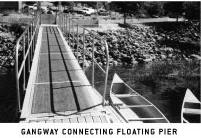
Gangway Alterations
Gangways on existing boating facilities may be repaired or replaced without triggering the requirement to increase the gangway length. However, if the areas altered contain primary functions (such as a boat slip or boat dock), existing gangways are considered part of the path of travel to the altered primary function area and must be made accessible, if the cost to do so is not disproportionate. The Department of Justice has determined that it is not disproportionate to spend up to an additional 20 percent of the overall costs of alterations to the primary function areas to make the path of travel accessible.
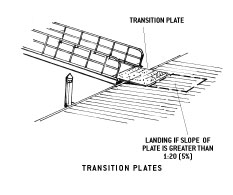
Transition Plates
Transition plates are sloping pedestrian walking surfaces located at the end of a gangway. Gangways are not required to have landings at the end, if transition plates are provided. If the slope of a transition plate is greater than 1:20 (5%), the transition plate must have a landing at the non-gangway end of the transition plate and comply with other ADAAG ramp requirements.
Handrail Extensions
ADAAG addresses handrail height, diameter, and extensions provided to the end of the gangway. Other specifications regarding vertical supports are not addressed by ADDAG, but may be addressed in local building codes. Handrail extensions are not required where gangways and transition plates connect and both are provided with handrails. ADAAG does not require handrails on sloped surfaces that have a rise of less than 6 inches or a projection less than 72 inches, or a slope of 1:20 (5%) or less. Where handrail extensions are provided, they do not need to be parallel with the ground or floor surface, since the surface may be moving due to water conditions.
Cross Slope
The cross slopes of gangways, transition plates and floating piers that are part of an accessible route must be designed and constructed to not exceed a maximum of 2 percent (1:50). Gangways and piers that are part of an accessible route are expected to be designed and constructed to meet the 2 percent requirement. Once placed in the water, measurements, absent live loads, are to be made from a static condition (i.e., absence of movement that results from wind, waves, etc.). Where floating piers are grounded out due to low water conditions, slope requirements would not apply.
Elevators and Platform Lifts
In addition to regular elevators, limited use/limited application elevators (smaller, slower elevators used for low-traffic, low-rise facilities) or platform lifts that comply with ADAAG may be used instead of gangways as part of an accessible route connecting floating piers.
Boats Slips
A boat slip is the portion of a pier, main pier, finger pier, or float where a boat is berthed or moored, or used for embarking or disembarking. Where boat slips are provided, the number of boat slips required to be accessible must comply with the table shown to the right. In these guidelines, boarding piers that are not part of boat launch ramps are also classified as boat slips. For purposes of these guidelines, piers not typically thought of as providing boat slips where boats can be moored, such as a fuel pier, are also included in determining the total number of slips at the facility.
Number of Accessible Boat Slips Required
| Total Boat Slips in Facility | Minimum Accessible Slips |
|---|---|
| 1 to 25 | 1 |
| 26 to 50 | 2 |
| 51 to 100 | 3 |
| 101 to 150 | 4 |
| 151 to 300 | 5 |
| 301 to 400 | 6 |
| 401 to 500 | 7 |
| 501 to 600 | 8 |
| 601 to 700 | 9 |
| 701 to 800 | 10 |
| 801 to 900 | 11 |
| 901 to 1000 | 12 |
| 1001 and over | 12, plus 1 for each 100 or fraction thereof |

If boat slips at a facility are not identified or demarcated by length, each 40 feet of boat slip edge along the perimeter of a pier will be counted as one boat slip. For example, a new boating facility will provide a single 60-foot pier with boats moored parallel to the pier on both sides. The pier has 120 feet of boat slip edge, which equates to three boat slips. According to the table, one slip must be accessible, with clear pier space at least 40 feet long and a minimum width of 60 inches. In this case, the width of the pier is not considered when totaling the amount of boat slip edge, since it is not designed for mooring. Another new boating facility plans to provide a single pier that is 25 feet long and 3 feet wide and will allow boats to moor on both sides and on one end. The pier has 53 feet of boat slip edge, which equates to two boat slips. According to the table, one slip must be accessible, and the width of the pier must be increased to a minimum of 60 inches.
Dispersion
Accessible boat slips must be dispersed throughout the various types of slips a facility provides, but a facility does not have to provide more accessible boat slips than required in the table. Accessible slips may be grouped on one pier if the requirement for different types of slips is met. Types could include shallow-water or deep water; transient or longer-term lease; covered or uncovered; and whether slips are equipped with features such as telephone, water, electricity, or cable connections.
 Accessible boat slips do not need to be marked and are not
reserved in the same way as accessible vehicle parking spaces. For
example, facilities should hold the accessible slips open for persons
with disabilities until all other slips are filled. At that point, the
slip may be made available for general use. For seasonal slip holders,
accessible slips should be held until the expiration period for slip
contracts has expired. Marina operators may choose to make information
regarding accessible boat slips available in promotional material or a
facility guide. Ensuring that accessible slips are available to persons
with disabilities is an operational issue and operators should contact
the Department of Justice for further information.
Accessible boat slips do not need to be marked and are not
reserved in the same way as accessible vehicle parking spaces. For
example, facilities should hold the accessible slips open for persons
with disabilities until all other slips are filled. At that point, the
slip may be made available for general use. For seasonal slip holders,
accessible slips should be held until the expiration period for slip
contracts has expired. Marina operators may choose to make information
regarding accessible boat slips available in promotional material or a
facility guide. Ensuring that accessible slips are available to persons
with disabilities is an operational issue and operators should contact
the Department of Justice for further information.
Accessible Boat Slips
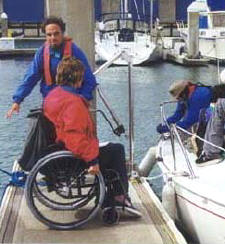 Accessible boat slips must have clear pier space at least 60 inches wide
and as long as the slip. Providing more than 60 inches wide clear space
will improve safety for people with disabilities, especially on floating
piers. This space is the minimum necessary for individuals with
disabilities to have sufficient space adjacent to their boat slip to use
a chair lift or transfer device for getting on or off their vessel and
provide a turning space for changing directions. Every 10 feet of linear
pier edge serving the accessible slips must have at least one continuous
clear opening that is at least 60 inches wide. There are three
exceptions:
Accessible boat slips must have clear pier space at least 60 inches wide
and as long as the slip. Providing more than 60 inches wide clear space
will improve safety for people with disabilities, especially on floating
piers. This space is the minimum necessary for individuals with
disabilities to have sufficient space adjacent to their boat slip to use
a chair lift or transfer device for getting on or off their vessel and
provide a turning space for changing directions. Every 10 feet of linear
pier edge serving the accessible slips must have at least one continuous
clear opening that is at least 60 inches wide. There are three
exceptions:
-
The width of the clear pier space may be 36 inches wide for a length of 24 inches, as long as multiple 36-inch segments are separated by segments that are 60 inches minimum clear in width and 60 inches minimum clear in length, and the clear openings are at least 60 inches deep.
-
Edge protection is not required, but if provided, it can be 4 inches high maximum and 2 inches deep maximum at the continuous clear openings.
-
In alterations, facilities with finger piers must have at least one accessible finger pier, which is the length of the boat slip and a minimum of 60 inches wide. Other accessible slips can be located perpendicular to the end of the pier with clearance extending the width of the slip. In facilities without finger piers, at least one accessible slip must be parallel to the pier and be a minimum of 60 inches wide.
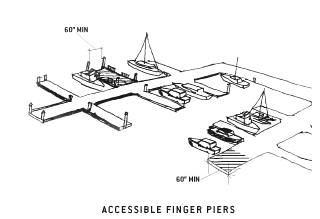
Cleats and other boat securement devices at accessible slips do not have to comply with ADAAG reach range requirements. However, clear space must be provided at each securement device and each device must be located on an accessible route. This reach range exception does not apply to other controls and operating mechanisms such as hose bibbs, water supply hoses, outlets for electrical power, telephones, or cable TV.
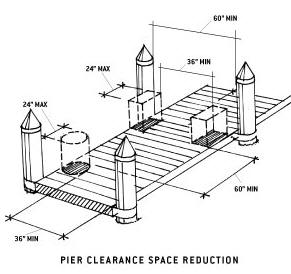
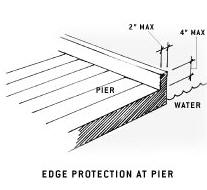
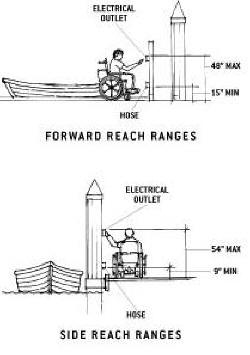
Boarding Piers at Boat Launch Ramps
A boarding pier (sometimes called a courtesy pier or a launch dock) is the part of a pier where a boat is temporarily moored for embarking and disembarking. A boat launch ramp is a sloped surface designed for launching and retrieving trailered boats and other watercraft to and from a body of water. The provisions for boarding piers cover only those that are associated with boat launch ramps. Boarding piers that are not part of a boat launch ramp are classified as “boat slips” for purposes of these guidelines.
If boarding piers at boat launch ramps are provided, at least 5 percent but not less than one, must comply with these guidelines and be served by an accessible route. The exceptions for gangways, previously described above, may be applied to boarding piers (see Accessible Routes).
In addition, gangways connecting floating boarding piers may exceed the maximum slope specified in the guidelines, if the total length of the gangway is at least 30 feet.
ADAAG ramp requirements do not apply to the portion of the accessible route serving a floating boarding pier or skid pier if it is located within a boat launch ramp. For example, a facility provides a chain of floats on a launch ramp to be used as an accessible boarding pier. At high water, the entire chain is floating and a transition plate connects the first float to the surface of the launch ramp.As the water level decreases, segments of the chain rest on the launch ramp surface, matching the slope of the launch ramp. An accessible route must serve the last float because it would function as the boarding pier at the lowest water level, before it possibly grounded out. Because the entire chain also functions as a boarding pier, it must comply with all ADAAG provisions, including the 60-inch minimum clear pier width provision.
Another facility provides a non-floating boarding pier that is supported by piles and divides a launch area into two launch ramps. An accessible route must connect the boarding pier with other accessible buildings, facilities, elements and spaces on the site. Although the boarding pier is located within a launch ramp, because the pier is not a floating pier or a skid pier, no exceptions apply. To comply with ADAAG, the accessible route could run down between the two launch ramps. Or, the fixed boarding pier could be relocated to the side of one of the launch ramps, which would allow the slope of the launch ramps to remain unchanged since the accessible route would run outside the launch ramps.
Boarding Pier Clearances
The entire length of accessible boarding piers must comply with the same technical provisions that apply to boat slips. There is no minimum length for the pier. However, the accessible boarding pier should be at least as long as other piers provided at the facility. If no other boarding pier is provided,it should be at least as long as what would have been provided if no access requirements applied. For example, at a launch ramp, if a 20-foot accessible boarding pier is provided, the entire 20 feet must comply with the pier clearance requirements. If a 60-foot accessible boarding pier is provided, the entire 60 feet must comply with the pier clearance requirements.
Launch Ramps Without Boarding Piers
 There
are no specific provisions that address access to launch ramps without
boarding piers. The Department of Justice advises that if there are no
applicable scoping requirements (i.e., how many features must be
accessible), then a reasonable number, but at least one, must be
accessible. It is recommended that an accessible route serve at least
one launch ramp. The portion of the accessible route located within the
launch ramp is not required to comply with the slope requirements for
accessible routes.
There
are no specific provisions that address access to launch ramps without
boarding piers. The Department of Justice advises that if there are no
applicable scoping requirements (i.e., how many features must be
accessible), then a reasonable number, but at least one, must be
accessible. It is recommended that an accessible route serve at least
one launch ramp. The portion of the accessible route located within the
launch ramp is not required to comply with the slope requirements for
accessible routes.
Provision Index
This table highlights the sections of the ADA and ABA Accessibility Standards discussed in the boating facilities guide.
| ADA Standards* | ABA Standards | |
| Definitions | 106.5 | F106.5 |
| Alteration | 106.5 | F106.5 |
| Boarding Pier | 106.5 | F106.5 |
| Boat Launch Ramp | 106.5 | F106.5 |
| Boat Slip | 106.5 | F106.5 |
| Cross Slope | 106.5 | F106.5 |
| Curb Ramp | 106.5 | F106.5 |
| Facility | 106.5 | F106.5 |
| Gangway | 106.5 | F106.5 |
| Ramp | 106.5 | F106.5 |
| Running Slope | 106.5 | F106.5 |
| Transition Plate | 106.5 | F106.5 |
| Recreation Boating Facilities (where provided) | 235 | F235 |
| Number of Accessible Boat Slips (including 40 foot rule) | 235.2 | F235.2 |
| Boat Slip Dispersion | 235.2.1 | F235.2.1 |
| Number of Acc. Boarding Piers at Boat Launch Ramps | 235.3 | F235.3 |
| Accessible Routes (where required) | 206 | F206 |
| Boating (specific provisions) | 206.2.10 | F206.2.9 |
| Load and Unload Areas (accessible route connection) | 206.2.9.1 | F206.2.9.1 |
| Elevators (types allowed) | 206.6 | F206.6 |
| Platform Lift (new construction use) | 206.7.10 | F206.7.10 |
| Accessible Routes Components (typically used) | ||
| Curb Ramps | 406 | 406 |
| Doors and Gates | 404 | 404 |
| Ramps (includes gangways) | 405 | 405 |
| Ramps (slope exception) | 1002.2 EX 1 | 1002.2 EX 1 |
| Walking Surfaces with Running Slopes of 5% or less | 403 | 403 |
| Gangway (specific alteration exception) | 1003.2.1 EX 1 | 1003.2.1 EX 1 |
| Gangway (max. rise exception) | 1003.2.1 EX 2 | 1003.2.1 EX 2 |
| Gangway (80 foot exception) | 1003.2.1 EX 3 | 1003.2.1 EX 3 |
| Gangway (25 boat slip exception) | 1003.2.1 EX 4 | 1003.2.1 EX 4 |
| Gangway (landing/transition plate exception) | 1003.2.1 EX 5 | 1003.2.1 EX 5 |
| Gangway (handrail exception) | 1003.2.1 EX 6 | 1003.2.1 EX 6 |
| Gangway (cross slope exception) | 1003.2.1 EX 7 | 1003.2.1 EX 7 |
| Gangway (surface exception) | 1003.2.1 EX 8 | 1003.2.1 EX 8 |
| Boarding Piers at Launch Ramps (exceptions in 1003.2.1) | 1003.2.2 EX 1 | 1003.2.2 EX 1 |
| Launch Ramp (30 foot exception) | 1003.2.2 EX 2 | 1003.2.2 EX 2 |
| Launch Ramp (slope exception - floating/skid piers) | 1003.2.2 EX 3 | 1003.2.2 EX 3 |
| Launch Ramp (surface exception from 1003.2.1 EX 8) | 1003.2.2 EX 1 | 1003.2.2 EX 1 |
| Technical Requirements for Boating Facilities | ||
| Clearances (size, and 10 foot rule) | 1003.3.1/.2 | 1003.3.1/.2 |
| Clearances (boarding pier, width exception) | 1003.3.2 EX 1 | 1003.3.2 EX 1 |
| Clearances (boarding pier, edge protection exception) | 1003.3.2 EX 2 | 1003.3.2 EX 2 |
| Clearances (boat slip, width exception) | 1003.3.1 EX 1 | 1003.3.1 EX 1 |
| Clearances (boat slip, edge protection exception) | 1003.2.1 EX 2 | 1003.2.1 EX 2 |
| Clearances (boat slip, alteration exception) | 1003.3.1 EX 3 | 1003.3.1 EX 3 |
| Cleats and Other Boat Securement Devices (exception) | 205.1 EX 7 | 205.1 EX 7 |
| Cross slope (boat slip exception) | 1003.2.1 EX 7 | 1003.2.1 EX 7 |
| Cross Slope (boarding pier exception, from 1003.2.1 EX 7) | 1003.2.2 EX 1 | 1003.2.2 EX 1 |
| Gas Pump (operation exception) | 309.4 EX | 309.4 EX |
| Other Typical Scoping Requirements at Boat Facilities | ||
| Dining surfaces | 226 | F226 |
| Employee Work Areas (exception) | 203.9 | no similar exception |
| Locker Rooms | 222 | F222 |
| Parking | 208 | F208 |
| Passenger Loading Zones and Bus Stops | 209 | F209 |
| Signage | 216 | F216 |
| Sales and Service Counters | 227.3 | F227.3 |
| Toilet and Bathing | 213 | F213 |
| Vending Machines | 228 | F228 |
* The guide uses the term ADAAG (Americans with Disabilities Act Accessibility Guidelines) as the basis of the requirements discussed. The recreational provisions of these guidelines were adopted into the 2010 ADA Standards without changes, so the ADAAG section numbers correspond to the same section numbers in the ADA Standards (as well as the Architectural Barriers Act (ABA) Accessibility Standards).




